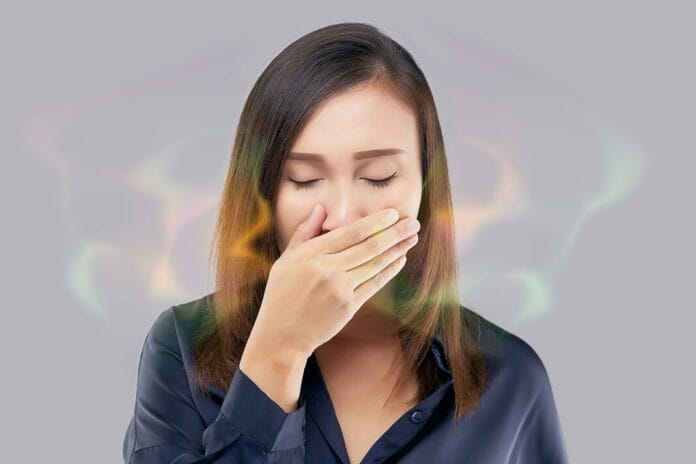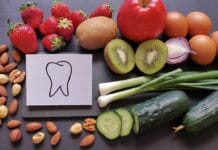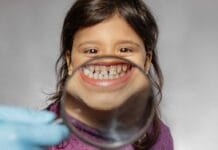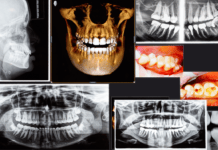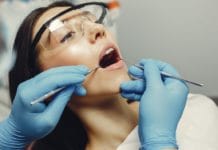“My breath smells bad.”
“My wife told me to see my dentist to address my bad breath.”
“I can’t taste food as well as before.”
“I can’t taste sweets as much as before.”
My patients have made these comments throughout my years as a dental hygienist. Halitosis and taste alteration remain major concerns for patients who experience them, as well as for clinicians seeking solutions. Beyond the clinical concern, halitosis can also affect people’s social experiences, confidence, and relationships.
Many factors may contribute to halitosis and taste alteration, including diet, gastrointestinal diseases, acid reflux, digestive complications, medications, xerostomia, systemic health, and oral hygiene. Lack of oral hygiene remains one of the most significant factors associated with halitosis and taste alteration.1
Halitosis
Halitosis is defined as an unpleasant odor that may or may not originate from the oral cavity. Studies suggest that up to 50% of the population may suffer from oral malodor, with the majority of cases due to poor oral hygiene.1 Periodontal disease, active decay, and tongue biofilm coating may also contribute to halitosis. Additionally, other conditions and medications that directly and indirectly affect oral health may lead to halitosis.1-4
The large surface area and papillary structures of the dorsal surface make its morphology ideal for harboring bacteria and favoring the accumulation of oral debris.5,6 The bacteria then metabolize the debris, creating volatile sulfur compounds that contribute to halitosis.5 Morita and Wang found a strong positive correlation between patients with heavy tongue coating and halitosis.7
Halitosis is perceived through olfaction and is caused by the breakdown of sulfuric and non-sulfuric amino acids by gram-negative anaerobes within plaque and biofilm. These bacteria include species belonging to the red complex, such as P. gingivalis, P. intermedia, F. nucleatum, T. denticola, and V. alcalescens. High concentrations of these bacteria are a hallmark of periodontal disease.1,3,4
Moreover, periodontitis, a chronic inflammation of oral tissues, is preceded by untreated gingivitis typically driven by bacterial involvement. The abundance of gram-negative anaerobic bacteria can trigger an inflammatory response, which often manifests as bleeding on probing (BOP), indicating a biofilm rich in red complex bacteria.8
Studies have shown that tongue coating and oral bacteria count are significantly associated with a higher incidence of halitosis. Although a positive relationship between probing depths and halitosis has been suggested in periodontally involved patients, current research provides only limited support for this hypothesis, leaving tongue coating with the strongest correlation.5
Taste Alteration
Taste disturbance can significantly diminish the enjoyment of food. Consequently, impaired appetite and decreased food intake may result, potentially leading to inadequate nutrition. Multiple factors, including changes in tongue papillae density and morphology, xerostomia, and saliva quality, influence taste perception.1,9,10
The four types of tongue papillae are the filiform, fungiform, circumvallate, and foliate. Fungiform papillae contain the largest number of taste buds (approximately 1,600), compared with foliate (several hundred) and circumvallate (approximately 250). Filiform papillae, in contrast, do not contain taste buds.11
Aging can lead to taste bud alteration and subsequent taste impairment. Additionally, aging is associated with a decrease in the number of fungiform papillae and a concurrent increase in filiform papillae. These changes in papillae density, coupled with reduced salivary production, often contribute to taste alteration.1,9
The quality of saliva also plays a role in taste perception, alongside xerostomia and taste bud alteration.12 The parotid gland, which produces up to 60% of saliva during mastication, secretes watery serous fluid containing serous acini.12,13 In contrast, the submandibular and sublingual glands are mixed glands that produce both mucous and serous acini.13 Parotid and submandibular glands also produce amylase, which aids in starch digestion.14 Consequently, a person with xerostomia may have difficulty tasting sweets due to the overall reduction in salivary flow, which is necessary to dissolve sweet stimuli and may be associated with reduced amylase activity.
Furthermore, Solamdal et al. found that older adults with excessive levels of lactobacilli experience alterations in sour taste. They hypothesize that because this bacterium produces acid, the resulting environmental adaptation of sour taste buds may increase the sour taste threshold. Additionally, xerostomia and excess plaque biofilm are associated with a decreased ability to taste salt.10
Outside of these established factors, the potential impact of removable appliances and tongue coating on taste perception remains inconclusive. While some studies have suggested an association, others report no difference between patient groups.1,10
In Closing
Halitosis is multifactorial, arising from systemic conditions, medication side effects, and, most frequently, poor oral health. The primary intraoral causes include xerostomia, active caries, excessive tongue coating, and poor oral hygiene. Addressing these key issues often resolves the condition.1-4
Taste alteration is influenced by aging (leading to changes in papillae density and morphology), xerostomia, and oral bacteria.1,9,10 Specifically, sweet taste may be affected by decreased amylase; sour taste, by excessive lactobacilli levels; and salt taste, by poor oral hygiene and xerostomia.10,14 However, due to the concept’s subjectivity and limited research, the etiology of taste alteration remains incompletely understood, necessitating further study.1,9,10,14
Although no positive correlation exists between halitosis and taste alteration, optimal oral hygiene and regular oral care are suggested as beneficial for both concerns.10
Before you leave, check out the Today’s RDH self-study CE courses. All courses are peer-reviewed and non-sponsored to focus solely on pure education. Click here now.
Listen to the Today’s RDH Dental Hygiene Podcast Below:
References
- Nalcaci, R., Baran, I. Factors Associated with Self-Reported Halitosis (SRH) and Perceived Taste Disturbance (PTD) in Elderly. Archives of Gerontology and Geriatrics. 2008; 46(3): 307-316. https://www.sciencedirect.com/science/article/abs/pii/S0167494307001288
- Cherney, K. Can Bad Breath Be a Sign that You Have a Cavity? (2023, May 5). Healthline. https://www.healthline.com/health/dental-and-oral-health/do-cavities-cause-bad-breath
- Cassiano, L.S., Leite, F.R.M., López, R., et al. The Association between Halitosis and Chemosensory Disorders: A Systematic Review. Oral Diseases. 2023; 29(2): 369-375. https://doi.org/10.1111/odi.13823
- Lee, Y.H., Shin, S.I., Hong, J.Y. Investigation of Volatile Sulfur Compound Level and Halitosis in Patients with Gingivitis and Periodontitis. Scientific Reports. 2023; 13(1): 13175. https://www.ncbi.nlm.nih.gov/pmc/articles/PMC10425441/
- Amou, T., Hinode, D., Yoshioka, M., Grenier, D. Relationship between Halitosis and Periodontal Disease – Associated Oral Bacteria in Tongue Coatings. International Journal of Dental Hygiene. 2014; 12(2): 145-151. https://pubmed.ncbi.nlm.nih.gov/23890391/
- Roldán, S., Herrera, D., Sanz, M. Biofilms and the Tongue: Therapeutical Approaches for the Control of Halitosis. Clinical Oral Investigations. 2003; 7(4): 189-197. https://pubmed.ncbi.nlm.nih.gov/14513303/
- Morita, M., Wang, H.L. Relationship between Sulcular Sulfide Level and Oral Malodor in Subjects with Periodontal Disease. Journal of Periodontology. 2001; 72(1): 79-84. https://doi.org/10.1902/jop.2001.72.1.79
- Carvalho, A.P., Moura, M.F., Costa, F.O., Cota, L.O. Correlations between Different Plaque Indexes and Bleeding on Probing: A Concurrent Validity Study. Journal of Clinical and Experimental Dentistry. 2023; 15(1): e9-e16. https://www.ncbi.nlm.nih.gov/pmc/articles/PMC9899362/
- Alia, S., Aquilanti, L., Pugnaloni, S., et al. The Influence of Age and Oral Health on Taste Perception in Older Adults: A Case-Control Study. Nutrients. 2021; 13(11): 4166. https://www.ncbi.nlm.nih.gov/pmc/articles/PMC8618294/
- Solemdal, K., Sandvik, L., Willumsen, T., et al. The Impact of Oral Health on Taste Ability in Acutely Hospitalized Elderly. PloS One. 2012; 7(5): e36557. https://www.ncbi.nlm.nih.gov/pmc/articles/PMC3343000/
- Tongue. (2022, April 25). Cleveland Clinic. https://my.clevelandclinic.org/health/body/22845-tongue
- Muñoz-González, C., Feron, G., Canon, F. Main Effects of Human Saliva on Flavour Perception and the Potential Contribution to Food Consumption. Proceedings of the Nutrition Society. 2018; 77(4): 423-431. doi:10.1017/S0029665118000113
- Ghannam, M.G., Singh, P. (2023, May 29). Anatomy, Head and Neck, Salivary Glands. StatPearls. https://www.ncbi.nlm.nih.gov/books/NBK538325/
- Martin, L.E., Gutierrez, V.A., Torregrossa, A.M. The Role of Saliva in Taste and Food Intake. Physiology and Behavior. 2023; 262: 114109. https://www.ncbi.nlm.nih.gov/pmc/articles/PMC10246345/

